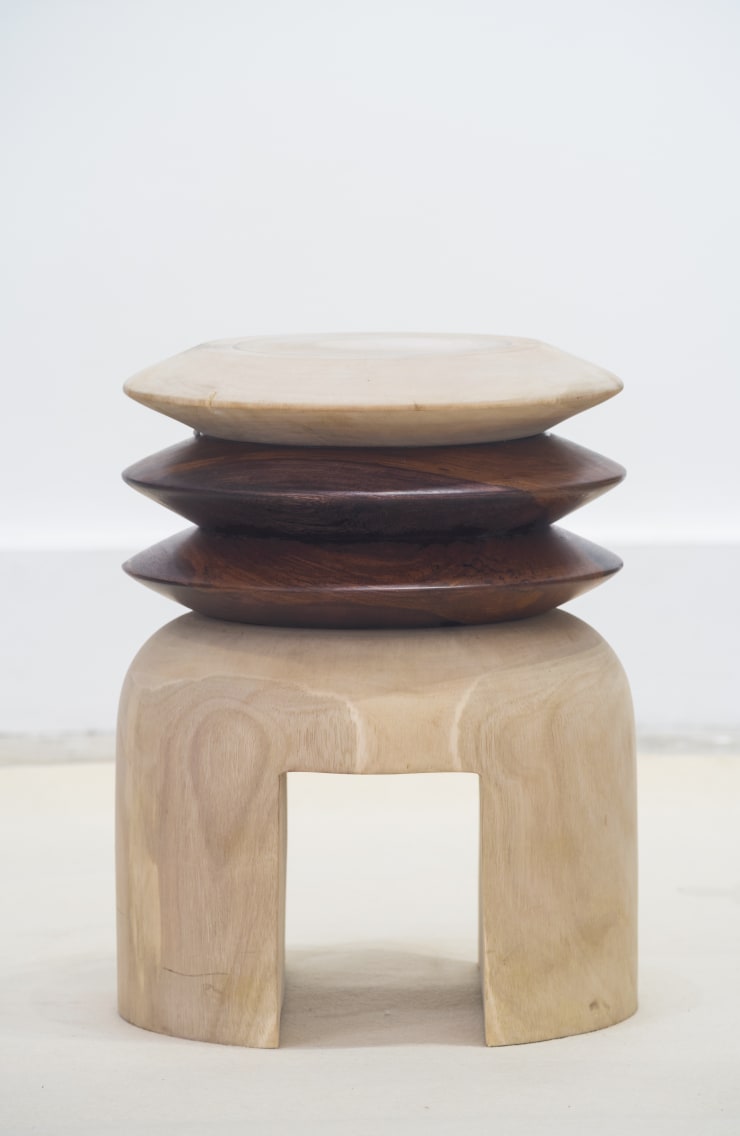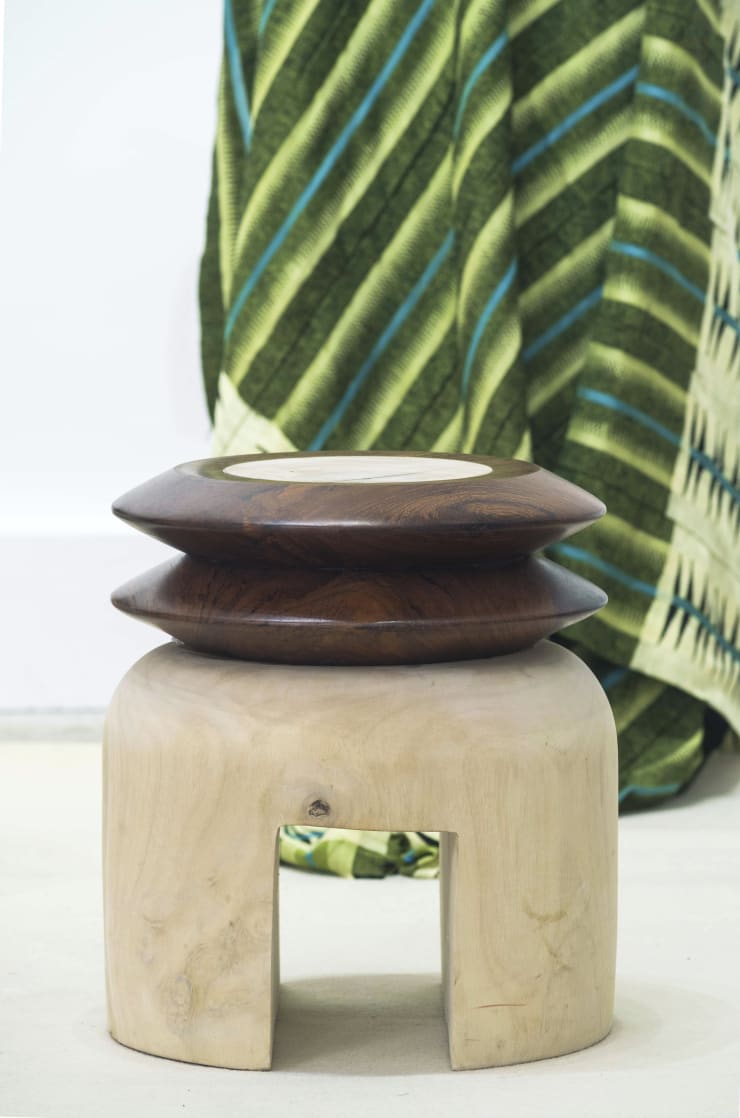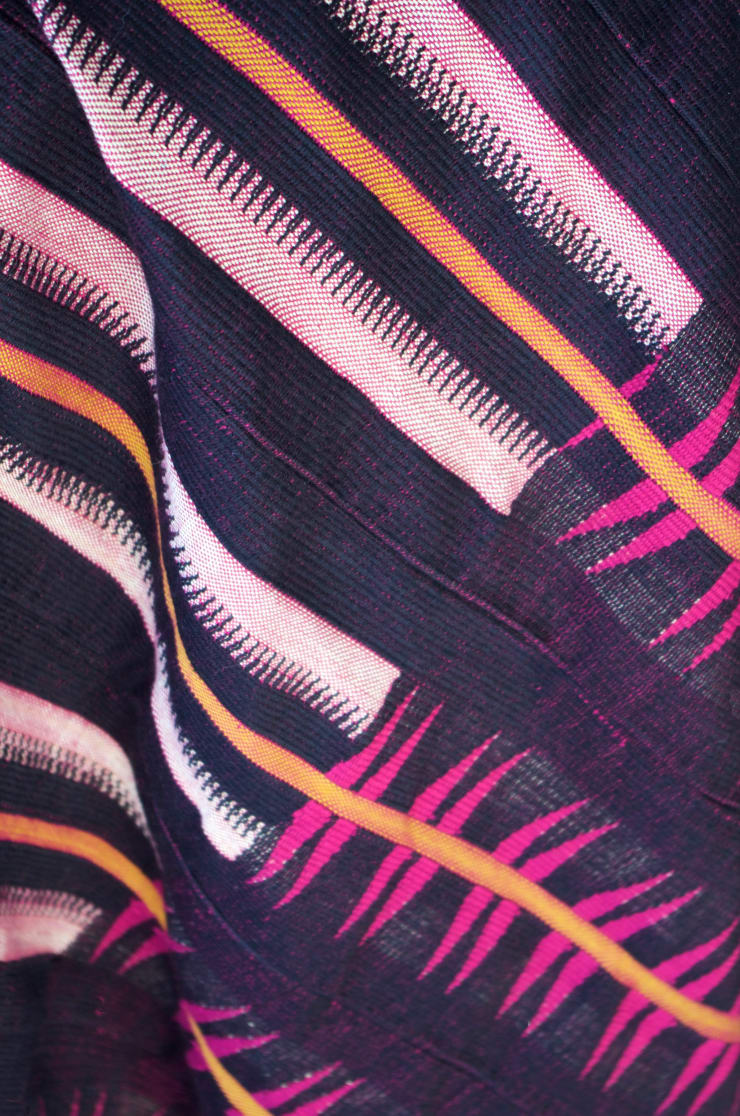Afrosubstancia: A solo exhibition of Estelle Yomeda
Galerie REVEL is pleased to present AFROSUBSTANCIA, Estelle Yomeda's first solo exhibition with the gallery. The show will be on view from February 9 to April 3, 2022. The exhibition presents EKKÖ Stool, the first collection of objects by the French-Togolese artist and designer Estelle Yomeda through the studio Kente Project of which she is the founder and artistic director. Also presented in the exhibition will be two textile works, entitled Kente, appearing as contemporary reimagining of traditional Kente cloths from West Africa.
EKKÖ Stool and the Kente textile works explore questions of memory, heritage, transmission and perpetuation of traditional know-how. These first two collections result, for the artist, from a long personal journey and a search for reconnection with the native land of his Togolese father who passed away when the artist was a child.
The EKKÖ collection is the result of an introspective journey that led Estelle Yomeda to discover ancient know-how through encounters with local craftsmen in Togo. The EKKÖ collection presents three independent sculptures made of two types of wood stacked on top of each other, thus evoking totem poles and serving as stools. Although the notion of totem in West Africa is not necessarily associated with a sculpture, it is nevertheless manifested by the symbolic power that the totem represents. To this end, a totem can be associated with a protective or defensive entity that has a sacred meaning for the person or family through a prohibition of.
The two distinct types of wood composing each totem are assembled to form a new entity. They refer to the notion of crossbreeding in a general way and more particularly in resonance with the personal history of the artist. From a structural point of view, each totem is composed of a solid Melina wood base on which are stacked circular cassia wood plates. The Melina (Gmelina Arborea) gives the base of the totems its pale blond color while the Cassia (Cassia Simea) gives the circular trays a darker tone. Both Melina and Cassia wood are locally sourced in Togo. Melina is a strong tree for its weight and is used as construction wood. Cassia is most often used as a reforestation and soil protection tree in the dry areas of Africa and Southeast Asia. Both are fast-growing trees and are therefore of interest in a sustainable environmental approach dear to the artist.
The contemporary interpretation of Yomeda's Kente textile works is the result of a process that echoes what originality is according to the renowned painter Ibrahim El-Salahi, one of the leading visual artists of the 'Khartoum School', a school considered as a component of African modernism. ‘Originality, human originality, does not mean creating something out of nothing because such a claim is far beyond the capacity of man. In my opinion, originality means being able to create something new from what already exists. One is simply making a new addition, a kind of new idea, a fresh leaf at the top of the same old tree of creation'. 1
Textiles, more than any other art form in Africa, represent a means of declaring status and/or exercising power. The term Kente has become a generic term used to describe the narrow silk banded cloth of the Asante (Ghana) and Ewe (Togo) peoples in particular.2 The production, use, and distribution of Kente textiles is one of the most prestigious symbols of leadership at the Asante (Ashanti) court in Kumasi, Ghana. Like the traditional ones, Estelle Yomeda's Kente are notable for their intricate weft inlay patterns covering the entire fabric. These were reserved for gods, kings and queens (Asantehene - king among the Asante) and royal families. The name of the overall pattern is derived from the warp band, but the artist calls it porcupines. This is in keeping with the tradition of naming each kente cloth after animals or rulers, proverbs, or particular historical events.
Contemporary artists such as El-Anatsui (b. 1944, Ghana) and Atta Kwami (1956 - 2021) have used the leitmotif of kente cloth to engage in two different conversations with their audiences.3 Presented in two dominant colors: green and purple, Yomeda's kente are imbued with a 'nomadic aesthetic' which El-Anatsui refers to in his works Man's Cloth and Woman's Cloth (2002) and defines as "the fluidity of ideas and impermanence of form, the unknown, as well as giving others the freedom, the authority to experiment with transformation (…)"4
Kente fabrics are part of the traditional West African textiles that punctuated the life of the people before the introduction of the 19th century Indonesian batik (which became wax in Africa) by the Dutch after its commercial failure in Indonesia. According to some Asante families, Kente is the translation of 'No matter what happens to it, it will not break'. Today, Kente are symbols of independence, strength, dynamism but also of memory and loss. They echo the meaning given to Yomeda's Kente, which are evocations of her personal paternal memory.
Favoring slow design and the reactivation of artisanal savoir-faire to perpetuate and transmit them, Estelle Yomeda creates timeless and contemporary works charged with energy and imbued with sacredness, symbolism and an ascetic vision of beauty outside of the standard canons and trends. Estelle Yomeda engages in a creative process of dialogue between the French decorative arts tradition and the traditional Togolese craft heritage.
The exhibition AFROSUBSTANCIA reveals the dualities inherent in Estelle Yomeda's practice: the light and the dark materialized by light and dark wood, the massive and the light materialized by the base and the circles stacked on the plinth, the personal and the universal, the feminine and the masculine, the strong and the poetic, the opposition and the reconciliation, the ancient and the contemporary.
4 - El Anatsui, 2006, Kate McCrikard 'Telephone Interview', in : El Anatsui, David Krut/October Gallery, Londres, New York).









